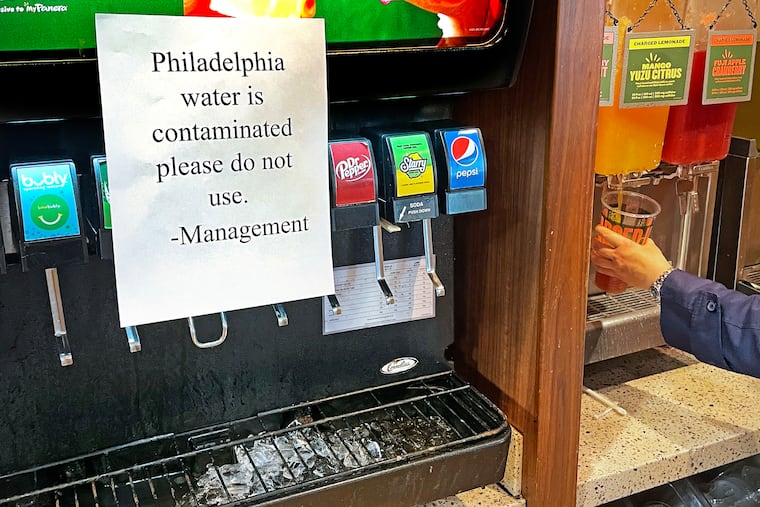Three steps to protect Philadelphia’s drinking water
Ensuring our right to clean drinking water requires a proactive government and an engaged populace.

Considering recent alarming news of drinking water pollution in Philadelphia, it may be surprising to learn that since 1971, the Pennsylvania Constitution has included the following provision: “The people have a right to clean air, pure water, and to the preservation of the natural, scenic, historic, and esthetic values of the environment. Pennsylvania’s public natural resources are the common property of all the people, including generations yet to come. As trustee of these resources, the Commonwealth shall conserve and maintain them for the benefit of all the people.”
On paper, Pennsylvania clearly takes environmental rights seriously. What about in practice?
Within the last decade alone, the Philadelphia region learned of three large-scale sources of water contamination. First, there is the ongoing release of “forever chemicals” (PFAS) to thousands of private water supply wells in the vicinity of the Naval Air Warfare Center in Warminster. Second, there is pervasive lead contamination of drinking water throughout the Philadelphia School District. Third, around 8,100 gallons of latex emulsion were released into the Delaware River at the Trinseo plant in Bristol on March 23, which triggered bottled water shortages and panic throughout the region.
Yet, this is only a part of the story. A recent analysis by The Inquirer identified six sites with known releases of toxic substances within one mile of the Delaware River below Trenton but above Philadelphia’s drinking water intake. Of these, a combined 4,105 pounds of hazardous chemicals leaked into the Delaware River over the last five years. Furthermore, our own analysis of this database identified an additional three toxic chemical release sites within a similar distance of the city’s drinking water intake on the Schuylkill, Philadelphia’s second-largest municipal water source. These sites combined for a release of over 720 pounds of hazardous materials to the Schuylkill over a similar time period (2018-2021) based on availability of Toxics Release Inventory reporting data.
These and other stressors to our region’s water supply point to the need for collective action to ensure our environmental human right to safe drinking water is being respected, protected, and fulfilled. This responsibility, however, does not just fall on the commonwealth. Here are three steps that leaders and the public can take to protect drinking water.
First, we need increased transparency and communication concerning water quality from our municipal leaders. It is impossible to protect our right to safe drinking water without open lines of communication between people who are impacted by contamination and those responsible for the pollution. The recent Trinseo spill was a failure in this regard; we still don’t know when city agencies were notified of the spill, the timing of collection for the first water samples to ensure our drinking water was safe, and why Philadelphia citizens were provided less than two-hour warning to purchase bottled water. There is clearly room for improvement.
Second, the Trinseo spill highlighted the need for municipalities to proactively engage with regulatory agencies to identify threats to its water supply, and for municipalities to hold polluters responsible. If we plan ahead, the city can prepare for the next water emergency by working with state regulatory agencies to identify major manufacturers and chemical storage facilities in upstream areas. While regulatory agencies should ensure that containment measures are in place in the event of a toxic spill, the city should have estimates for how long a toxic chemical will take to travel to a drinking water tap in Philadelphia and develop procedures to test for various contaminants.
Finally, we as the public must be more engaged in the process of ensuring our environmental human right to safe drinking water. We need to not only hold our elected leaders accountable but to proactively participate in solutions within our community. This can look like ensuring our political representatives understand their constituents’ priority for safe drinking water (the upcoming city elections are a perfect starting point), placing economic and public pressure on known polluters within our communities, and collaborating with conservation agencies that preserve land in our source watersheds.
Watersheds are the sum of their parts, and we will only be able to secure access to safe drinking water with both a proactive government and an engaged populace and business community. The environmental, social, and economic implications of drinking water contamination are too dire to ignore.
Steven Goldsmith is an associate professor in the department of geography and the environment at Villanova University. Jen Santoro is a visiting assistant professor in the department of geography and the environment at Villanova University. Chris Jeffords is an associate teaching professor in the department of economics at Villanova University.